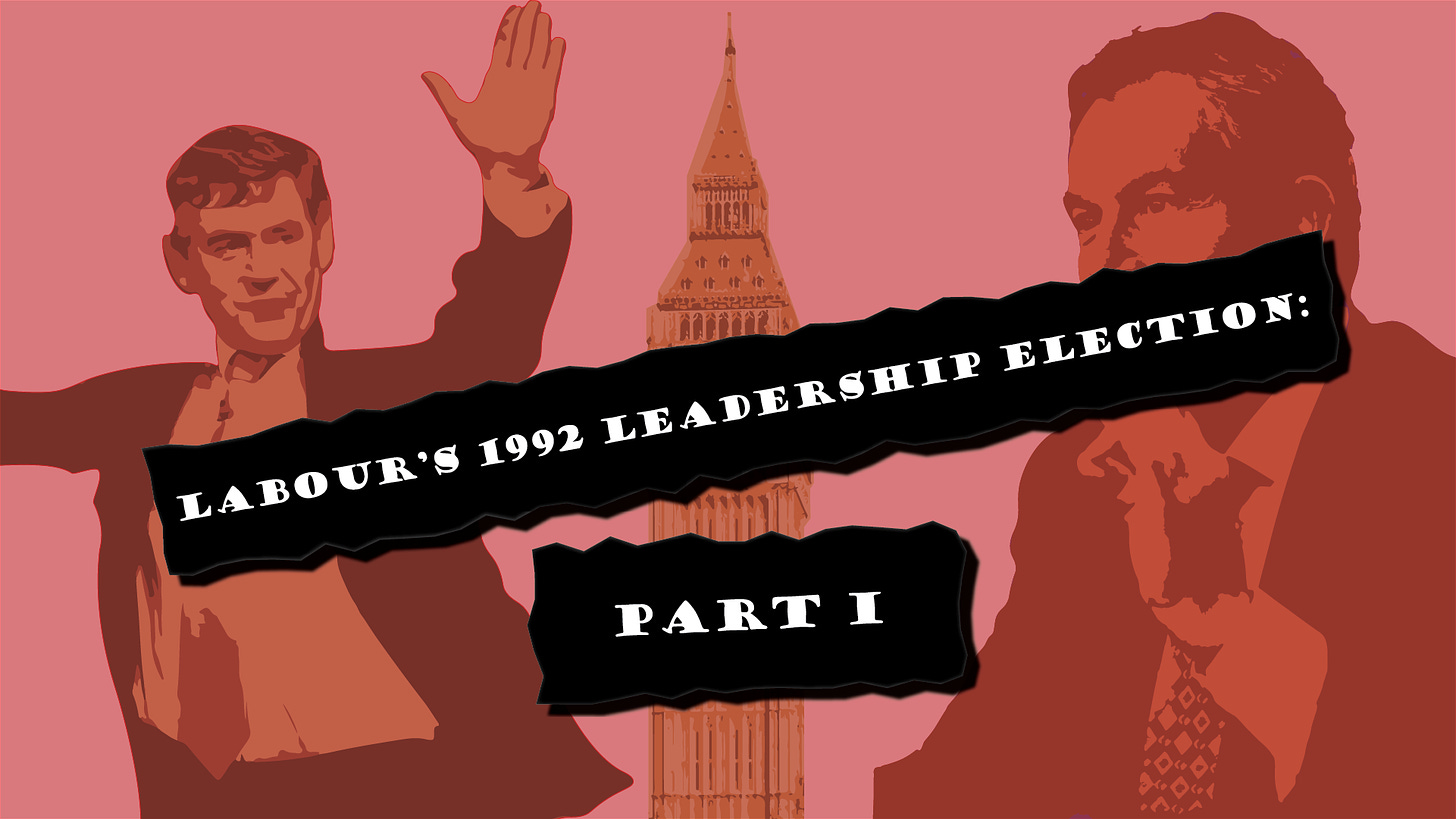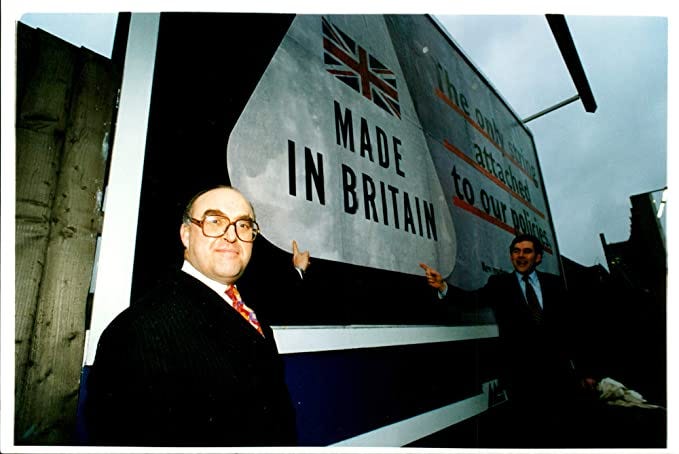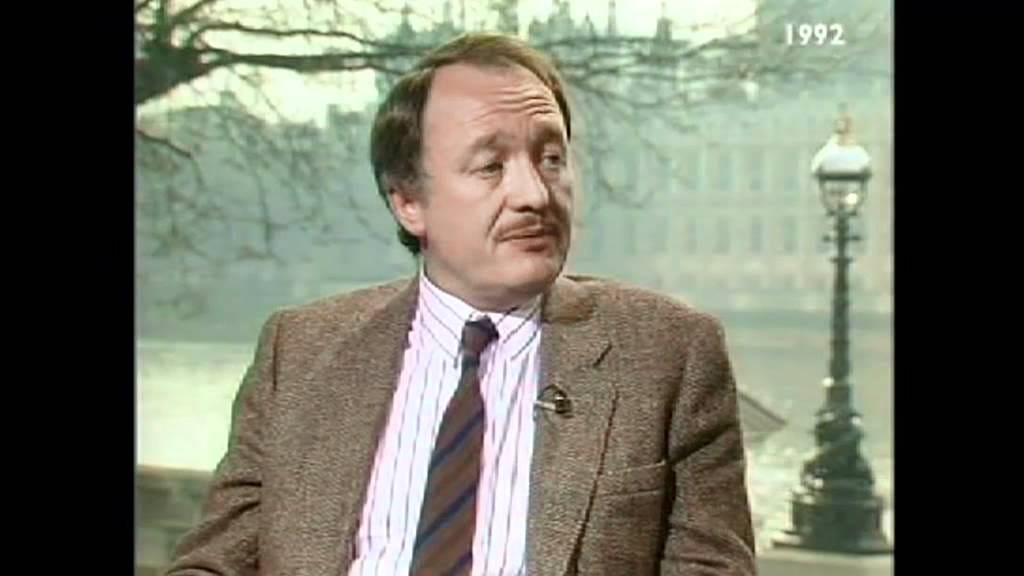Labour’s 1992 leadership election: Part I
Guerrilla warfare over process erupts as candidates jockey for MP nominations.
After leading the party to two electoral defeats, Neil Kinnock’s position as Labour leader was untenable. But he didn’t need to go right away. He wasn’t made a scapegoat for the election failure—some corners of the Labour party were even praising him improving on the election performances of 1983 and 1987.
Many anticipated that he would stay on until the party conference in October, providing ample time to conduct a full post-mortem on the election and rally members behind a new leader. Kinnock’s resignation the day after the general election caught many in the party off guard.
Kinnock’s last wish
The Conservative government had a small majority was overseeing a precarious economy with deep issues. Kinnock knew that as a lame duck leader his ability to apply pressure to John Major and his cabinet was muted. He stepped aside in the hope that the new leader would be able to assemble a shadow cabinet before the summer recess in July, allowing he or she to hold the government’s feet to the fire over the summer break.
For Kinnock, that meant a swift succession, ideally concluded by the end of June. Leadership contests in the 1980s had been vicious affairs with plenty of mudslinging and Kinnock feared a return to the days of internal conflict and a weakened opposition. In his mind, the quicker a new leader took the helm, the more pressure Labour could apply to the Conservative government.
Others saw the merits of waiting. Local elections were less than a month away. A leadership contest, they felt, would be a distraction and a drain on party resources at a time when they should be concentrated on local races. Additionally, without Kinnock around to defend himself, it was possible that elements in the party would try to pin the election failings on the outgoing leader and prevent an accurate and frank assessment of the 1992 campaign.
“We need to have a debate on policy rather than be plunged into an immediate leadership election”—Jeremey Corbyn
In the end, neither side got what they wanted. A specially convened National Executive Committee (NEC) meeting decided that the electoral college would meet on July 18 to decide the next Labour leader, ignoring Kinnock’s preference for a June contest, but much earlier than the October conference. Nominations to decide which candidates made it onto the final ballot would be tallied on April 28th.
Not the time for political manoeuvrings
Polling showed 53 percent of the public thought John Smith would make the best successor to Neil Kinnock. The next popular replacement was Gordon Brown with 2 percent of the vote.
Tony Blair tried to persuade Brown to run. Not to win—if Smith ran, he was certain to win the leadership contest—but to raise the profile of the young group of moderniser MPs.
Not to be outmanoeuvred by Blair, the more experienced political operator Smith had already spoken to Brown and promised him the position of shadow chancellor in his shadow cabinet providing he didn’t run for leader. The idea of standing as deputy leader was out of the question as an all-Scottish ticket in Smith and Brown would have been an election liability.
“I felt I had to be loyal… I never thought for a minute of standing against John Smith,” Brown reflected in his memoirs. Brown was also 12 years Smith’s junior at 41-years-old. He had plenty of time to fulfil his leadership ambitions.
For a moment, Blair considered running for deputy leader, but changed his mind when party support seemed to be coalescing around Shadow Chief Secretary to the Treasury Margaret Beckett. According to Peter Mandelson, Gordon Brown had disliked the idea anyway (possibly because it would have allowed Blair to position himself in the public mind as a future leader).
More of the same?
In addition to John Smith, the party’s spokesman on environmental affairs, Bryan Gould, announced his candidacy for both the leadership and deputy leadership races. An outspoken Eurosceptic, he saw Smith as a continuation of Kinnock, arguing, “we cannot simply change the face at the top and expect to win in 1996 on the program on which we lost in 1992.”
On the left, the former leader of the Greater London Council and MP for Brent East, Ken Livingstone, announced his leadership bid on April 16. He railed against Smith’s proposed tax hikes and pinned them in large part for the party’s election failure; his preferred funding source for increased public investment were cuts to defence spending.
The deputy leadership, a more open contest, drew more candidates. In addition to Gould, Margaret Beckett, the trade union favourite with the backing of the Transport and General Worker’s Union (TGWU), John Prescott, the Shadow Secretary of State for Transport, Ann Clwyd, Shadow Minister for Overseas Development, and Bernie Grant, the left-wing MP for Tottenham, all threw their hats into the ring.
Discord over the contest’s timing was quickly overshadowed by more vicious internal strife over who would even get on the ballot. As of 1988, candidates needed to secure nominations from 20 percent of the 271 Labour MPs to mount a leadership challenge, or 55 nominations. A tall order for many of the candidates.
A union stitch up?
A Smith-Beckett victory was the preferred scenario for trade unions and the modernisers in the party. Smith’s Scottish roots could hold Labour support in Scotland, while Beckett’s representation of a Midland seat made her palatable to both Northern and Southern voters. Both were moderates, with Beckett’s left slant complementing Smith’s right. The male-female ticket was also optimal as Labour recognised the need to shed its masculine working-class image to reach more female voters.
Both the Smith campaign and the trade unions knew that they needed opposition candidates to run against. There had already been suspicions that the trade unions had been pushing for an early leadership contest to rush Smith and Beckett into office. An uncontested race would reignite questions over the trade union influence and could cast doubt on their legitimacy.
On Friday April 24th, just four days before nominations closed, it didn’t look like any of Smith or Beckett’s opponents would meet the threshold of 55 nominations.
Bryan Gould’s campaign asked the party’s Director of Organisation Joyce Gould (no relation) if MPs could submit their second choice candidate with their nomination that could be counted in the event their first choice failed to meet the threshold. She implied that they could. Smith and Beckett’s teams naturally did not object, but other candidates in the race were incensed.
Ken Livingstone accused the party of trying to fix the nomination process. He had a point. The 20 percent threshold had been implemented to stop left-wing candidates like him and Bernie Grant using a leadership race to promote their platform. If the party wanted to put arbitrary mechanisms in place to curtail the influence of the left, then they needed to accept the consequences, not fiddle with it midway through a leadership contest to generate a more favourable outcome.
Labour Party officials quickly backtracked in the face of the accusations. At a Parliamentary Labour Party (PLP) meeting on April 27, the day before nominations closed, General Secretary Larry Whitty told MPs that Joyce Gould had not meant to suggest MPs could submit second choice candidates, but only to clarify that MPs could withdraw their nominations and replace them with a new nomination at any point up until nominations closed the following afternoon.
Livingstone hit out again. No nomination tallies were to be released before the final count, so MPs had no idea whether their nominated candidate was close to the threshold. Livingstone saw it as a last-ditch attempt to get MPs to switch support from him, Ann Clwyd, and Bernie Grant, and accused the party of “deliberately lying to cover its tracks.”
“It is an outrage. We are in danger of having a complete farce”—Ken Livingstone
On April 28, 1992, the nominations were tallied. In the end, Ann Clwyd withdrew from the race hours before the deadline, allowing her MP supporters to redistribute their nominations.
In the leadership race, John Smith received 162 nominations to Gould’s 63. Livingstone’s 13 nominations weren’t enough to meet the threshold, winnowing the contest down to a two-horse race.
The deputy leadership nominations yielded three candidates. Beckett had the most nominations at 89. Gould received 69, and John Prescott 64. Bernie Grant secured 15, not enough to run. There were suggestions that Ann Clwyd had secured around 30 nominations at the time of her withdrawal which were then redistributed.
A sign of things to come?
The fraught battles over first the timing and then the nomination process didn’t bode well for the campaign to come. David Blunkett and others worried that the accusations of a trade union stitch up had set the stage for a leadership campaign bogged down in debate over internal mechanisms and organisation that would be uninspiring to the wider electorate.
The first phase of leadership selection was over, but the party had taken a battering at its own hands. The party looked like it was tearing itself apart over internal procedure and the trade unions and constituency branches, known sticklers for process, hadn’t even had their say yet.






